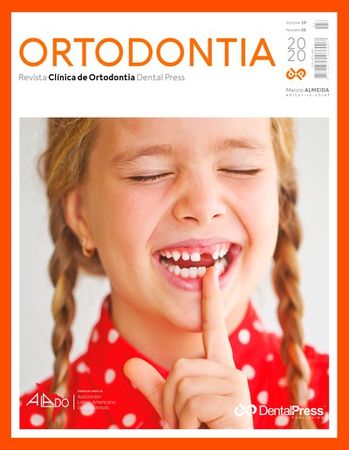Editorial Board
Autores: Marcio Rodrigues de Almeida,
messages.RevistaAutores:
LEIA MAIS
Orthodontics based on clinical practice or scientifi c evidence?
In our current time, in which the world has beenfacing a pandemic for about 8 months (Covid-19),several treatment protocols have been institutedin an empirical or unscientific way, given thatthere was little time to carry out more in-depthscientific studies on the topic, using well-sizedor...
Autores: Marcio Rodrigues de Almeida,
messages.RevistaAutores:
LEIA MAIS
Letter to the editor
First, we would like to thank Revista Clinica deOrtodontia Dental Press, and its Chief Editor,Marcio Rodrigues de Almeida, for the opportunityto present our critical evaluation of themethodology adopted in a paper published bythe referred journal in its 18th volume, number6. We would also like to...
Autores: Jaime Sampaio Bicalho, Rafael De Faria Bicalho, Karla Tonelli Bicalho Crosara, Silvano Barbosa De Oliveira,
messages.RevistaAutores:
LEIA MAIS
Author’s reply
First of all, we would like to thank the distinguishedprofessionals Dr. Jaime Sampaio Bicalho,Dr. Karla Tonelli Bicalho Crosara, Dr.Rafael de Faria Bicalho and Dr. Silvano Barbosade Oliveira for the critical evaluation ofour article “Unexpected effects of modified3x3 retainers related to gingival...
Autores: Adilson Luiz Ramos, Giovana Romano De Oliveira, Debora Reis Dias, Roberto Masayuki Hayacibara,
messages.RevistaAutores:
LEIA MAIS
An interview with Marcio Sobral
I was very glad to be invited to coordinate the interview ofthis dear colleague, a long-time friend with whom I shared,side by side, a large part of my professional trajectory. MárcioSobral graduated from the Federal University of Bahia (UFBA),Brazil, in 1994, and his studies were focused on...
Autores: Gustavo Mattos Barreto, Arthur Farias, Perpétua Freitas, Marcelo Castellucci, Máyra Seixas,
messages.RevistaAutores:
LEIA MAIS
The little giant
It’s amazing how skeletal anchoring has completelychanged our specialty. The introduction ofmini-implants in Brazil, on a large scale, beganin mid-2000s, and our practice has never beenthe same ever since. Before its incorporation,we used to obtain, as we still do today, excellentresults in...
Autores: Marcos Janson,
messages.RevistaAutores:
LEIA MAIS
Biomechanics of the extrusion arch
INTRODUCTION: The anterior open bite has a prevalenceof almost 20% in children and presents manystrategies for its correction. OBJECTIVES: The objectiveof the present study was to describe an extrusionarch in order to treat the anterior open bite in a mixeddentition patient.
Autores: Marcio Rodrigues de Almeida, Juliana De Brito Vasconcelos,
messages.RevistaAutores: orthodontics, Malocclusion, Anterior open bite,
LEIA MAIS
Virtual orthodontic model trimming: hit or bias?
INTRODUCTION: orthodontic trimming models are good allies to diagnosis, whether 2D or 3D, andare very successful mainly as study models. From acorrect positioning of the bases, we can comprehend thecorrect position of dental arch and the smile line of patients.Anyhow, this procedure can be a bias...
Autores: Cristiane B. André,
messages.RevistaAutores: orthodontics, Dental models , Diagnosis, Three-dimensional imaging,
LEIA MAIS
OutKlean®– Aligner Remover and Cleaner
INTRODUCTION: The evolution in the design of theattachments and the greater number of them in mechanics,promotes more precise tooth movements and, consequently,results in better adaptation and retention of the aligner tothe dental arch, which makes its removal diffi cult. Therefore,devices that...
Autores: Liliana ávila Maltagliati, Mayara Paim Patel, Marcos Coral Scocate, Murilo Matias, Vivian De Souza Lourenço, Ana Carla Raphaelli Nahás Scocate,
messages.RevistaAutores: orthodontics, Oral hygiene, Patent, Clear orthodontic aligners,
LEIA MAIS
Preadjusted bracket positioning on canines substituting absent maxillary lateral incisors
INTRODUCTION: The substitution of congenitally missingmaxillary lateral incisors with mesial movement of thecanines impose some clinical challenges to orthodontist.OBJECTIVE: This article highlights a clinical tip of thebracket placement in canines to facilitate achieving morenatural-looking...
Autores: Giordani Santos Silveira, Dauro Douglas Oliveira, Amanda Rafaela Diniz,
messages.RevistaAutores: Anodontia, Orthodontic space closure, Dental Esthetics,
LEIA MAIS
Supernumerary tooth from diagnosis to treatment: case report
INTRODUCTION: Supernumerary teeth, or hyperdontics,are number-related developmental changes, and theirpathogenesis is determined during the initiation andmorphogenetic phases of odontogenesis. When locatedin the region of upper incisors they are called mesiodens.The main complications caused by...
Autores: Michelle Coelho Ferreira Lotito, Ana Clara Vega Martinez Veras Ferreira, Mônica Tirre de Souza Araújo,
messages.RevistaAutores: Orthodontics, Tooth abnormalities, Pathology, oral, Tooth supernumerary,
LEIA MAIS
Extra-alveolar skeletal anchorage in treatment of skeletic Class III - case report
INTRODUCTION: Temporary extra-alveolar skeletalanchorage devices (DTAEA) represent a major innovationin orthodontics and can provide good orthodonticanchorage in clinical practice, requiring nopatient cooperation. These devices are small in size,high strength, easy to install, and enable...
Autores: Luiz Fernando Eto, Randerson Menezes Cardoso, Guaracy Lyra Da Fonseca Júnior, Rômulo D ́ávila Pedrini, Ney Tavares Lima Neto, Luciana Karla De Morais Santos, Juliana Cama Ramacciato,
messages.RevistaAutores: Orthodontic Anchorage Procedures, Tooth Movement Techniques, Orthodontics, corrective,
LEIA MAIS
In vitro study of the surface roughness of an acrylic resin used for making removable orthodontic appliances
INTRODUCTION: In rehabilitated teeth, the presence ofsurface roughness, besides being uncomfortable, leadsto the accumulation of biofi lm, becoming a potential riskfactor for caries and periodontal diseases. OBJECTIVE:Considering that self-curing acrylic resins are widely used inthe manufacture...
Autores: Bruno Lima Minervino, Marcelo De Morais Curado, Ana Paula Sandes Bragança, Francisco Xavier Paranhos Coêlho Simões, Marcelo Sousa Gomes,
messages.RevistaAutores: Orthodontic appliances, Acrylic resins, Porosity, removable,
LEIA MAIS
Orthodontic treatment of skeletal Class II malocclusion in a patient with secondary microcephaly
INTRODUCTION : Orthodontic treatment of Class IImalocclusion is widely acknowledged and discussedin the literature. The conditions that make treatmentmore or less complex depend on the particularities ofeach patient. The complexity of orthodontic treatmentis greater in patients with special needs....
Autores: Fábio Lourenço Romano, Mírian Aiko Nakane Matsumoto, José Tarcísio Lima Ferreira, Murilo Fernando Neuppmann Feres, Maria Cristina Borsatto,
messages.RevistaAutores: Malocclusion, Angle Class II, Extraoral traction appliances, Quality of life, Craniofacial abnormalities,
LEIA MAIS
Orthodontic and Surgical treatment of a patient with skeletal deformity, obstructive sleep apnea and dental ankylosis
INTRODUCTION: The aim of this paper was to describe theclinical case of a patient with convex profi le, mandibularretrusion, facial asymmetry, gingival smile, obstructivesleep apnea, severe dental malocclusion and ankylosisof the upper right central incisor. DESCRIPTION: Thepatient was treated...
Autores: Cátia Cardoso Abdo Quintão, Marco Antonio De Oliveira Almeida, Felipe De Assis Ribeiro Carvalho, Rhita Cristina Cunha Almeida, Henrique Martins Da Silveira, Ana Beatriz Neves Pereira, Carolina Considera Vogas,
messages.RevistaAutores: Malocclusion, surgery, Facial asymmetry, Angle Class II, Sleep apnea, obstructive,
LEIA MAIS
Skeletal Class III malocclusion treatment: from childhood to end of adolescence
Prevalence of Class III skeletal malocclusion in Brazil isbetween 2 and 5%. It is a condition identifi ed by parents orfamily, who seek care at an early age. Class III treatmentwhen performed by maxillary protraction has been shownto be very effi cient, especially in patients with defi ciencyof the...
Autores: Fábio Lourenço Romano, Mírian Aiko Nakane Matsumoto, Murilo Fernando Neuppmann Feres,
messages.RevistaAutores: Corrective Orthodontics, Angle Class III malocclusion, Interceptive orthodontics,
LEIA MAIS













.png)
